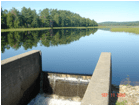Home → Fish & Wildlife → Wildlife → Lands → Lands Management Program
Lands Management Program

Photo by R. Robicheau
The Lands Management Program is charged with implementing habitat management and planning for Department owned Wildlife Management Areas (WMAs); a process that provides for a coordinated management approach statewide in conjunction with the Regional Wildlife Biologists. Its mission is to maintain and improve habitat conditions across IFW’s ownership with an approach based on management activities to create or maintain optimum wildlife habitat, maximize biological diversity and protect unique natural areas.
The Lands Management Program is also charged with creating, maintaining and improving public access infrastructure on the WMAs. These included such activities as boundary line identification and maintenance, participation in the Department’s land acquisition efforts, keeping WMAs clean from illegal dumping and assisting the public in inquiries about recreational activities.

Photo by R. Robicheau
The Lands Management Program aims to educate the private and other public ownerships about the benefits of active management for wildlife through use of the WMAs as demonstration areas where techniques and activities used by the Department can be seen in action.
In forested habitats, the primary tool for habitat management is timber harvesting. By varying the type of timber harvesting, certain forest conditions and the habitat conditions offered by those forests can be created or maintained. Whether promoting softwood cover for white-tailed deer habitat, hardwoods such as oak and beech for the mast produced by those tree species, or creating early successional habitat for grouse and woodcock - the main way to achieve this is through timber harvesting.

Photo by R. Robicheau
Current Management Activities
Frye Mountain Compartment J WMA Habitat Management
The Frye Mountain Wildlife Management Area is one of Maine’s most popular wildlife management units occupying approximately 5200 acres in portions of the towns of Knox, Montville and Morrill, all in Waldo County. The 643-acre compartment of Frye Mountain scheduled for habitat work provides opportunities to manage for white-tailed deer cover and forage, as well as improved habitat for grouse, woodcock and turkey. Increased vertical structure resulting from harvesting activity will benefit numerous songbird species, as well.
Portions of the compartment contain favorable cover for overwintering deer, but adequate forage is lacking. Harvesting will remove some hardwood stems resulting in regeneration becoming available for browse over the course of the next few years. Portions of the compartment also contain a strong aspen component which is preferred by ruffed grouse for cover and budding. Woodcock, like grouse, also prefer dense low cover for a portion of their yearly life cycle and will benefit from harvesting in aspen-dominated stands managed for grouse. Additionally, regeneration resulting from winter harvesting in more moist soils adjacent to wetter sites will provide cover in foraging areas favored by woodcock. Maintained fields within the compartment represent areas for woodcock courtship.
Red oak is a common hardwood component throughout Frye Mountain and the compartment scheduled for activity is no exception. Some of the harvesting activity will favor increased crown development of oak for the continued production of hard mast in the form of acorns. Acorns are an excellent source of food for deer and turkey in particular though a variety of mammal species will take advantage of hard mast. Wild apple trees are also common throughout the compartment. Harvesting activity will release them from overhead competition and fall up treatments will include pruning to facilitate increased soft mast production benefiting birds and mammals.
Work at Frye Mountain is expected to occur in the winter of 2020, resume for part of the summer and conclude in the winter of 2021. Scheduled summer maintenance of the Sunnyside Cemetery Road will facilitate improved access for all user groups.
For more information, please email Lands Management Biologist Eric Hoar at Leigh.E.Hoar@maine.gov.
Ongoing Management Activities

Photo by R. Robicheau
Continuous and ongoing management activities occurring on a seasonal or yearly basis include the following:
- Manipulation of optimum water levels for waterfowl habitat
- Field mowing and maintenance
- Boundary line maintenance
- Road maintenance
- Apple and other fruit tree maintenance
- Herbaceous seeding
Updates (Public Meeting and Presentations)
- A reminder that seasonal road closures in some areas will take place after the firearm deer season comes to an end. This is undertaken to protect the road infrastructure to ensure continued recreational opportunities. Please check back to see upcoming closure notices.
- Currently there are no public meetings or presentations scheduled.